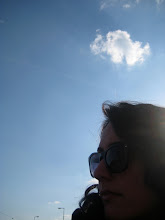Note: All pictures beyond this point were taken today, and all images coexist within the same structure.

The religious and cultural struggle between Islam, Christianity and Judaism remains a key element in understanding Spain's history and, in some ways, Spain's present. With a history that includes a Golden Age, followed by multiple expulsions of the Muslims and the Jews (the very groups of people responsible for such a Golden Age), Spain's cultural and religious history remains long and complicated. However, the interesting part about Spanish history is that it is still alive today; we can still feel this struggle through Andalucia, especially in Córdoba, where the influence of all three cultures resonates throughout the people, the architecture, the food and even the street names.
 La Mezquita is both a mosque and a church. It boasts Roman and Islamic arches yet is filled with Christian capillas (chapels). At first glance, the structure appears to be a hodgepodge; the architectural elements span centuries, cultures, religions, etc. However, while such sections are culturally and religiously conflicted, la Mezquita exists as a grand historical entity that, despite its contradictions, represents a cohesive cultural structure. While many elements are at work within this one building, they all coexist within their own relative beauty and style, and as such, la Mezquita remains a living example of Spanish history.
La Mezquita is both a mosque and a church. It boasts Roman and Islamic arches yet is filled with Christian capillas (chapels). At first glance, the structure appears to be a hodgepodge; the architectural elements span centuries, cultures, religions, etc. However, while such sections are culturally and religiously conflicted, la Mezquita exists as a grand historical entity that, despite its contradictions, represents a cohesive cultural structure. While many elements are at work within this one building, they all coexist within their own relative beauty and style, and as such, la Mezquita remains a living example of Spanish history.  So which culture and religion reign supreme? Do the Muslims have the right to Córdoba since they were here 800 years before the Christians? Or do the Jews deserve more than la Judería because of the role they played in the Spanish Golden Age centuries ago? Or does Córdoba belong to the Christians, the last group to reconquer the city that was once the Islamic capital of the Western world? Personally, I don't think the city belongs to just one culture, one race, one ethnicity, or one religion. If anything, the city of Córdoba belongs to one history, a history consisting of the multiple cultures, races, ethnicities and religions that have passed through, lived within and constructed the city as a physical and ethnic entity. And so, I think that la Mezquita represents a tangible and realistic truth: that all paths, despite their differences, CAN in fact lead to God and CAN in fact coexist peacefully within one history. The history of Córdoba.
So which culture and religion reign supreme? Do the Muslims have the right to Córdoba since they were here 800 years before the Christians? Or do the Jews deserve more than la Judería because of the role they played in the Spanish Golden Age centuries ago? Or does Córdoba belong to the Christians, the last group to reconquer the city that was once the Islamic capital of the Western world? Personally, I don't think the city belongs to just one culture, one race, one ethnicity, or one religion. If anything, the city of Córdoba belongs to one history, a history consisting of the multiple cultures, races, ethnicities and religions that have passed through, lived within and constructed the city as a physical and ethnic entity. And so, I think that la Mezquita represents a tangible and realistic truth: that all paths, despite their differences, CAN in fact lead to God and CAN in fact coexist peacefully within one history. The history of Córdoba.

Hi Samantha! I will be following you!
ReplyDeleteooooh good :-) just what I wanted! haha
ReplyDelete